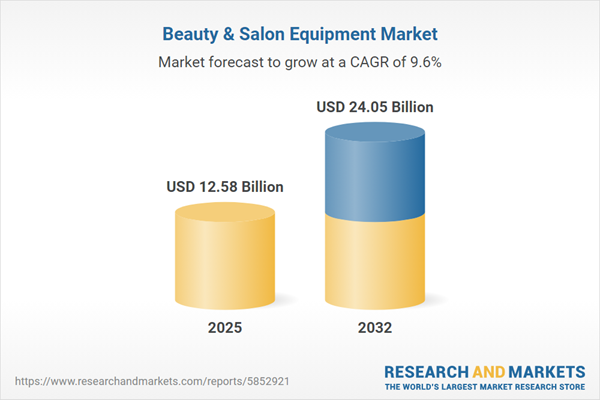Speak directly to the analyst to clarify any post sales queries you may have.
Senior decision-makers in the Beauty & Salon Equipment Market are navigating a rapidly evolving sector where digital transformation, regulatory developments, and changing consumer preferences require agile leadership and strategic foresight.
Market Snapshot: Beauty & Salon Equipment Market Growth Trajectory
The Beauty & Salon Equipment Market is poised for robust growth, achieving a projected market value of USD 11.53 billion in 2024. With expectations to reach USD 12.58 billion by 2025 and a compound annual growth rate (CAGR) of 9.61% anticipated through 2032, the sector’s total value is set to climb to USD 24.05 billion. Rapid advancements in digitization, increased consumer prioritization of health outcomes, and evolving compliance requirements are major drivers shaping this upward trajectory. Businesses taking a proactive stance on sustainable technology integration and regulatory response remain competitive, maintaining adaptability and operational momentum within a dynamic business landscape.
Scope & Segmentation: Strategic Dimensions in the Beauty & Salon Equipment Market
Comprehensive segmentation strategies are essential for senior executives wishing to optimize resources and navigate complexity within the Beauty & Salon Equipment Market. Understanding these strategic dimensions enables refined targeting and better risk management across products, regions, and applications.
- Product Types: Salon furniture, hair care instruments, massage beds and chairs, nail care devices, and advanced skin systems support both established and emerging revenue streams, offering versatility for professional and home users.
- Technologies: Manual and automated solutions, including equipment embedded with smart sensors, mobile connectivity, and integrated data tools, enhance service customization and operational insight across business functions.
- Distribution Channels: Direct retail outlets, specialty stores, wholesale channels, digital commerce, and online platforms expand access and service delivery to a diverse customer base in both mature and developing markets.
- Applications: Commercial salons, franchise models, wellness and healthcare centers, independent beauty parlors, and home-use segments underscore the market’s flexibility and ability to address unique end-user demands.
- Regions: Geographical coverage includes the Americas, Europe, Middle East, Africa, and Asia-Pacific, each impacted by specific regulatory environments, cultural preferences, and supply chain considerations.
- Leading Companies: Market leadership is shaped by key players such as Dyson, L’Oréal S.A., Alma Lasers Ltd., BabylissPRO, Candela Corporation, and Clinique Laboratories LLC, whose strategic initiatives and innovation underpin sector progress.
Key Takeaways: Strategic Insights for Senior Decision-Makers
- Digital integration across equipment offerings drives efficiency, sharper diagnostics, and tailored experiences, thereby boosting long-term customer engagement.
- Sustainable procurement and logistics practices reinforce business credibility and strengthen alignment with stakeholder expectations in environmentally driven markets.
- Regulatory complexity encourages more thorough vetting of suppliers and partners; clear transparency in value chains safeguards operations and reputation.
- New product design and adoption of advanced beauty technologies unlock potential in less-saturated and remote markets, especially for home-use applications.
- Collaboration among technology providers, manufacturers, and end users facilitates steady product evolution and supports agile adjustments to regulatory changes.
- Subscription models and bundled services encourage repeat business and help companies withstand market fluctuations.
Tariff Impact: Responding to Shifting US Import Duty Rates
Adjustments in US import duty rates are prompting organizations to revisit their manufacturing and sourcing strategies. Embracing solutions like increased domestic production and localized product development helps businesses maintain compliance while also progressing toward broader sustainability objectives. These shifts provide greater control over supply chains and improve organizational responsiveness as policy landscapes change.
Methodology & Data Sources
This analysis draws on comprehensive secondary research, reviews of trade and regulatory data, and insights from industry experts. By combining diverse information sources, the report provides accurate and practical guidance for executives active in the Beauty & Salon Equipment Market.
Why This Report Matters: Actionable Intelligence for Decision-Makers
- Equips leaders with clarity on supply chain optimization for regulatory compliance amid evolving commercial conditions.
- Delivers strategic insights into technology adoption and sustainability, fostering cohesive planning and stronger industry collaborations.
- Provides scenario-focused intelligence to support adaptive risk management and proactive response to future market developments.
Conclusion
Empowered with reliable market analysis, decision-makers can steer sustained transformation, strengthen operational resilience, and capitalize on new opportunities emerging from digital advancements and sustainability priorities within the Beauty & Salon Equipment Market.
Additional Product Information:
- Purchase of this report includes 1 year online access with quarterly updates.
- This report can be updated on request. Please contact our Customer Experience team using the Ask a Question widget on our website.
Table of Contents
3. Executive Summary
4. Market Overview
7. Cumulative Impact of Artificial Intelligence 2025
Companies Mentioned
The companies profiled in this Beauty & Salon Equipment market report include:- Dyson
- L'Oréal S.A.
- Alma Lasers Ltd.
- BabylissPRO
- Candela Corporation
- Clinique Laboratories, LLC
- Conair LLC
- Cutera, Inc.
- Elchim s.p.a.
- FOREO AB
- Jemella Limited
- Koninklijke Philips N.V.
- LightStim International, Inc.
- MTG Co., Ltd
- Lumenis Be Ltd.
- Nu Skin Group
- Panasonic Holding Corporation
- Parlux
- Proactiv by Taro Pharmaceuticals USA Inc.
- QuasarMD
- Remington by Spectrum Brands, Inc.
- Revlon Consumer Products LLC
- The Procter & Gamble Company
- TRIA BEAUTY
- Trophy Skin Products LLC
- VEGA Industries Private Limited
- YA-MAN LTD.
- ZIIP Inc.
Table Information
| Report Attribute | Details |
|---|---|
| No. of Pages | 190 |
| Published | November 2025 |
| Forecast Period | 2025 - 2032 |
| Estimated Market Value ( USD | $ 12.58 Billion |
| Forecasted Market Value ( USD | $ 24.05 Billion |
| Compound Annual Growth Rate | 9.6% |
| Regions Covered | Global |
| No. of Companies Mentioned | 29 |









